Eaton has expanded its popular 9PX UPS line with the new addition of a lithium-ion model. Lithium-Ion brings with it a host of benefits like longevity, faster charge time, and lower weight when compared to lead-acid cousins. The new 9PX UPS offers “set and forget” simplicity with power ratings from 1.5 to 3 kVA and a variety of software tools to enable intelligent management at scale. As the 9PX is intended for a variety of use cases including remote edge and SMB server rooms, Eaton offers several capacities, as well as rackmount and tower form factors, to meet any deployment need.
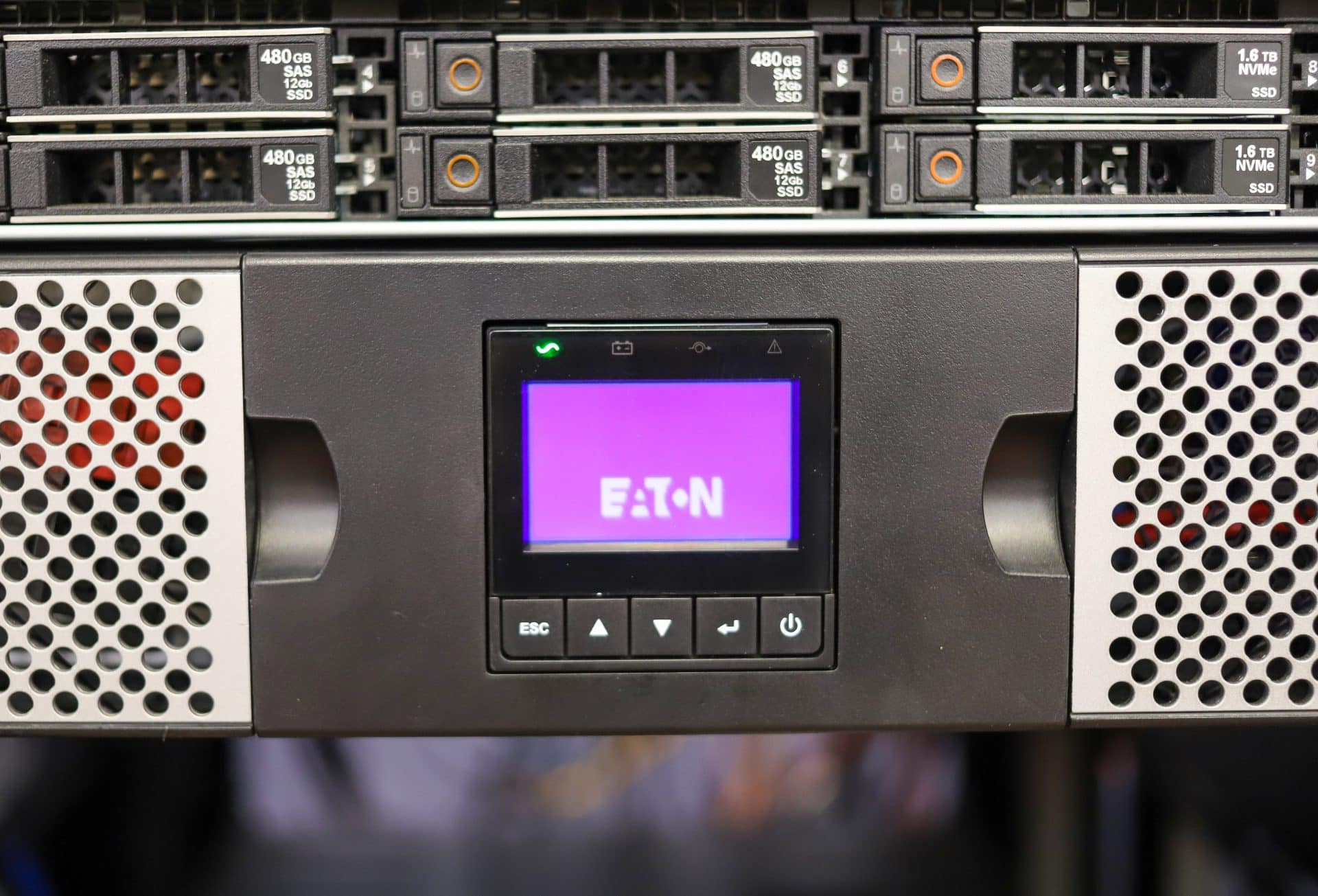
Lead-Acid vs. Lithium-Ion Batteries
First, let’s look at a quick recap of lead-acid and lithium-ion batteries and why you may want one over the other. Lead-acid batteries have been around for nearly 200 years. The technology has been proven out, though there aren’t many advancements being made. The battery relies on a chemical reaction (with sulfuric acid) to generate/store power. A big issue with them is big-ness, they are typically large and heavy. If you need to back up a few racks of gear, you are going to need lots of extra space, and a floor to hold them. These batteries can take longer to charge and if discharged too much, they can lose some capacity. They can deliver less energy at higher loads as well.
The history is a bit fuzzy, but Lithium-ion batteries have been around for about 35 years, give or take. The first commercial version came to market in 1991. This battery type also relies on a chemical reaction and comes in various types. The lithium-ion batteries take care of several of the cons of the lead-acid battery. They are way denser, smaller, and lighter for the same charge. They can also charge much quicker and don’t lose energy under high loads. While the upfront costs are higher, they tend to last longer. Lithium-ion batteries are fairly safe, you probably have one in your pocket or are reading this on a device with one in your hand.
This gets right to the crux of choosing the Eaton 9PX lithium-ion UPS over the lead-acid version. While you will pay more upfront, the lithium-ion battery can last two to three times as long. The lithium-ion battery can run longer and it is roughly 20% lighter. On top of that, it comes with a 5-year warranty versus the 2-year warranty of the lead-acid version.
There are a few models within this family, but for our purposes and this review, we will be looking at the Eaton 9PX lithium-ion UPS model 9PX1500RT-L with a list price of $3,869.
Eaton 9PX lithium-ion UPS Specifications
| Topology | Double-conversion, online | |
| Configuration | Rack/tower | |
| Color | Black and silver | |
| Diagnostics | Full system self-test at power up | |
| Warranty | 5 years electronics and battery | |
| Rail kit |
|
|
| Remote power off | Remote On/Off (ROO) and Remote Power Off (RPO) rear terminal blocks | |
| Electrical input | 120V | 208V |
| Nominal voltage | 120V default (100/110/120/125V) | 208V default (200/208/220/230/240V) |
| Input voltage range | Full load: 100-144V, <30% load: 60-144V | Full load: 176-276V, <40% load: 100-276V |
| Frequency | 50/60 Hz | |
| Frequency range | 60 Hz: 50–70 Hz, 50 Hz: 40–60 Hz | |
| Input power factor | >.99 | |
| Input current distortion | <5% (<10% frequency converter mode) | |
| Circuit breaker | 1500VA: None 2000VA: None 3000VA: (3) 20A for (2) 5-20R each |
1500VA: None 2200VA: None 3000VA: None |
| Electrical output | 120V | 208V |
| Power ratings |
|
|
| Nominal voltage | 120V default (100/110/120/125V) | 208V default (200/208/220/230/240V) |
| Output voltage
regulation, steady state |
±1% normal mode ±2% battery mode | |
| Voltage THD (online) | Linear: 3% Non-linear: 5% | |
| Power factor | 0.9 | |
| Efficiency | 9PX1500RT-L: 90%online 9PX2000RT-L: 91.4% online 9PX3000RT-L: 91.6% online |
9PX1500GRT-L: 92% online 9PX2200GRT-L: 93% online 9PX3000GRT-L: 93.7% online |
| Transfer time | 0ms | |
| Battery | ||
| Optional extended battery module(EBM) | 9PXEBM48RT-L: 1500 VA models (1U form factor) 9PXEBM72RT-L: 2000-3000 models (1U form factor) |
|
| Maximum number of EBMs | Add up to 4 EBMs | |
| Battery description | Lithium Ion, LiFePO4 chemistry | |
| Battery management | BMS: Advanced battery management with health monitoring and prediction features | |
| Battery replacement | Hot-swappable internal batteries and EBMs | |
| Start on battery | Cold-start enabled; first cold start is always forbidden | |
| Communications | ||
| User interface | Graphical display. UPS status in a single view. | |
| LEDs | 4 status-indicating LEDs | |
| Communication ports | RS-232 (RJ45) ports; USB port as standard (HID). 6-foot RS-232 and USB cables included | |
| Communications card | NETWORK-M2 card optional, standard on network bundles (bundled models include an N) | |
| Power management software | Integrates with Eaton Intelligent Power Manager software | |
| Environmental & standards | ||
| RoHS compliance | Yes | |
| Surge protection | MOV ratings: 271Volt (from L-N) and 510 Volt (from L-G and N-G), 190 Joules | MOV: 510V, 296 Joules |
| EMC markings | IEC 62040-2 Cat C1 / CISPR22 / FCC part 15 Class B / VCCI Class B | IEC 62040-2 Class B Cat C2 / CISPR22 Class B / FCC part 15 Class B / VCCI Class B |
| Heat dissipation (BTU) | 9PX1500RT: 512 online,897 battery 9PX2000RT: 578 online,974 battery 9PX3000RT: 844 online,1462 battery | 9PX1500GRT: 494 online, 731 battery 9PX2200GRT: 513 online, 741 battery 9PX3000GRT: 619 online, 1150 battery |
| Audible noise | <47 dB at 1 meter | |
| Operating temperature | 0 to 40°C (32°F to 104°F) | |
| Altitude operating temperature range | 0-1500m @ 0°C – 40°C 1500m-3000m @ 0°C – 35°C | |
| Safety conformance | CE/cULus/NOM | CE / cULus |
| Storage temperature | -20 to 35°C (-4°F to 95°F); without batteries: -13 to 55°C (5°F to 131°F) | |
| Relative humidity | 0 to 96% non-condensing | |
Design and Build
The Eaton 9PX lithium-ion UPS looks more or less like a 2U version of the 9PX. The newer model can be rack-mounted or used in a tower configuration. The bigger benefit to the tower configuration this go-round is that it uses less overall space. A 4-post rail kit is included along with tower feet, but you can get a 2-post kit from Eaton as well. We use several of Eaton’s racks which the new lithium-ion battery fits right into.
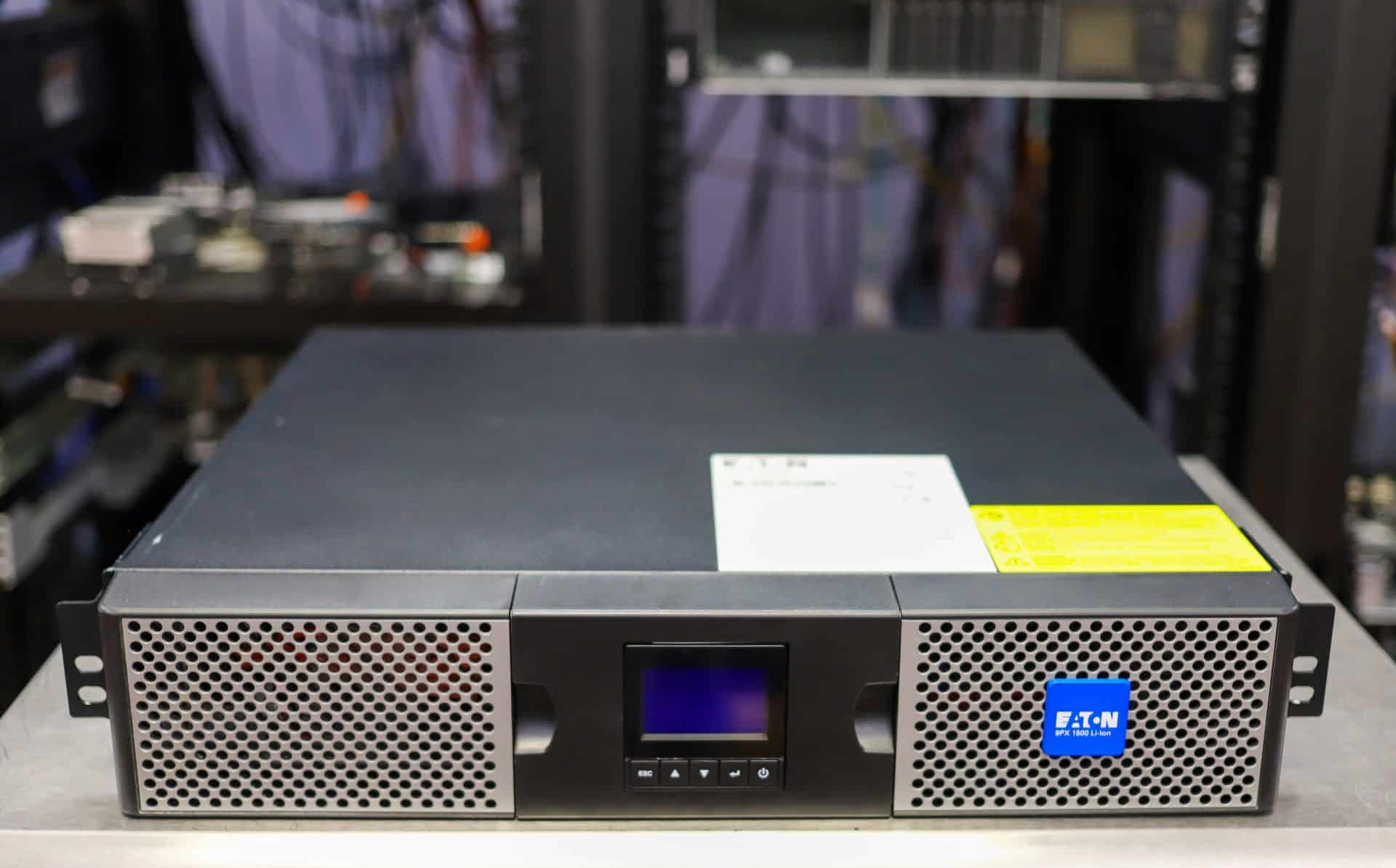
The front of the device has two vented panels to get airflow to the battery on either side. The center of the battery has a five-button graphical rotating/tilting LCD screen that offers various information about the UPS, including the load status, events, measurements, and settings. Above the LCD are the status indicators: Online mode indicator (green), Battery mode indicator (orange), Bypass mode indicator (orange), and the Fault indicator (red). Below is the escape, up, down, enter, and on/off buttons to navigate the menus.
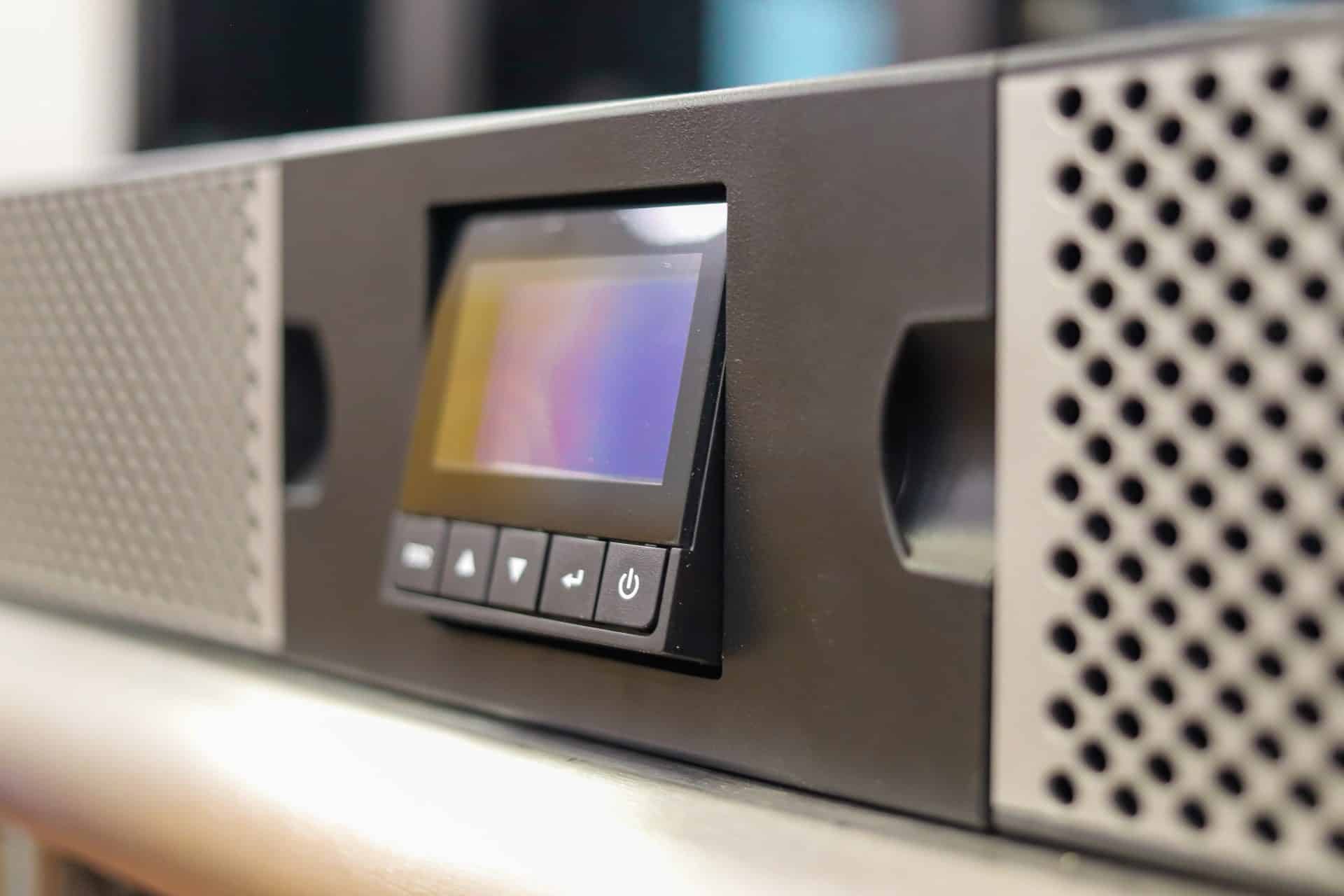
Flipping it around, on the right side are two sets of 5-15R load segment outlets in two groups, four total. Moving to the left are four 5-15R managed outlets. Next to them is the EBM connector and a ground bonding screw. Continuing on our leftward journey, we see the output relay port with the external battery module detection port under it. Further over is the network-M2 card and an RS-232 serial port near the bottom with a USB next to it. This is followed by a remote power off and remote on/off port. On the left side are the fan and the power cord.
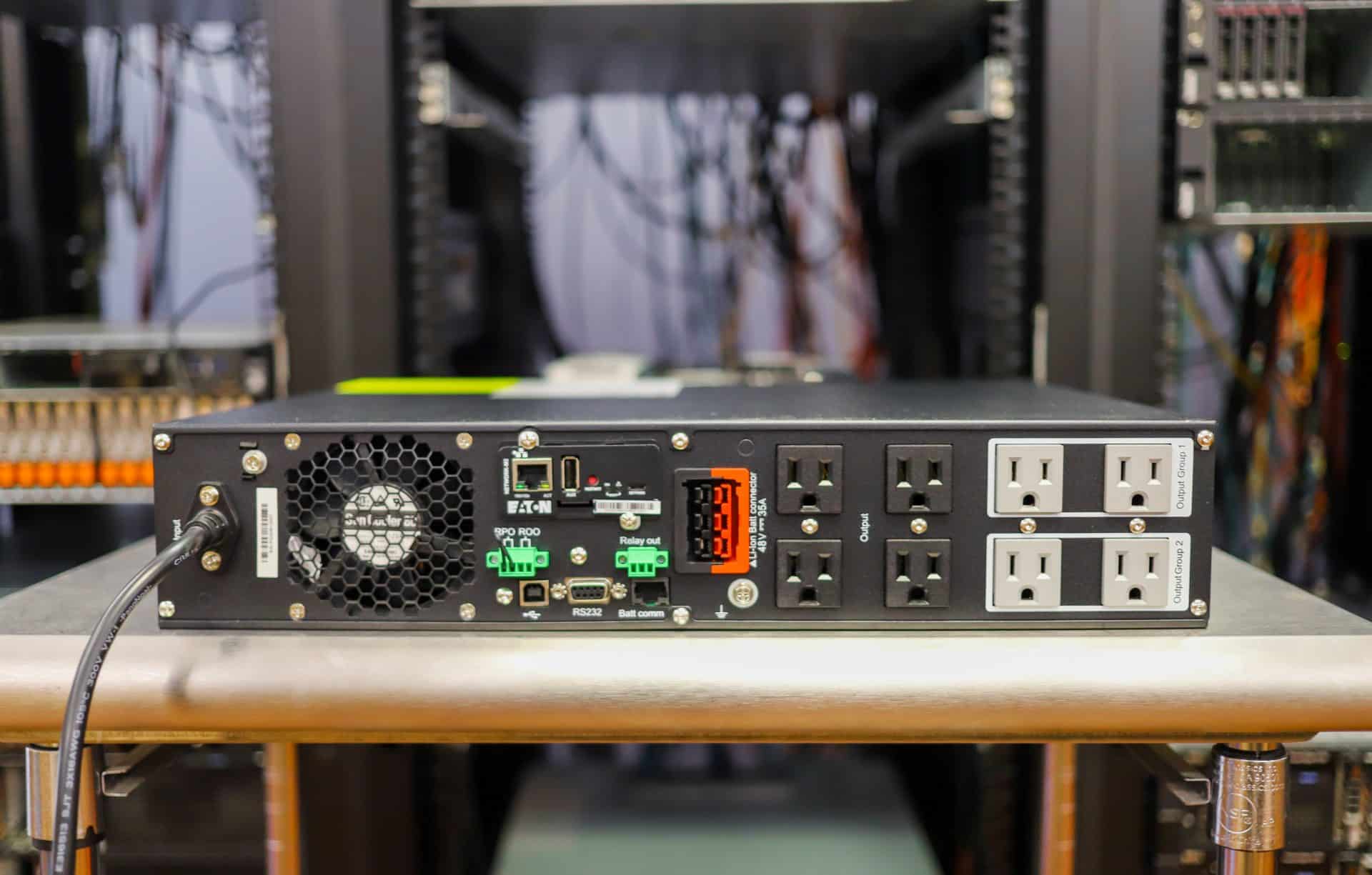
Eaton 9PX lithium-ion UPS Usability
While the “set and forget” nature of the Eaton 9PX lithium-ion UPS is appealing there is much more one can do other than just plugging things into it and going on vacation, though that’s an option. Eaton actually has several management options. The three main ones are Intelligent Power Management (IPM), Visual Power Manager (VPM), and PredictPulse Insight that belong to the Eaton Brightlayer Data Centers suite.
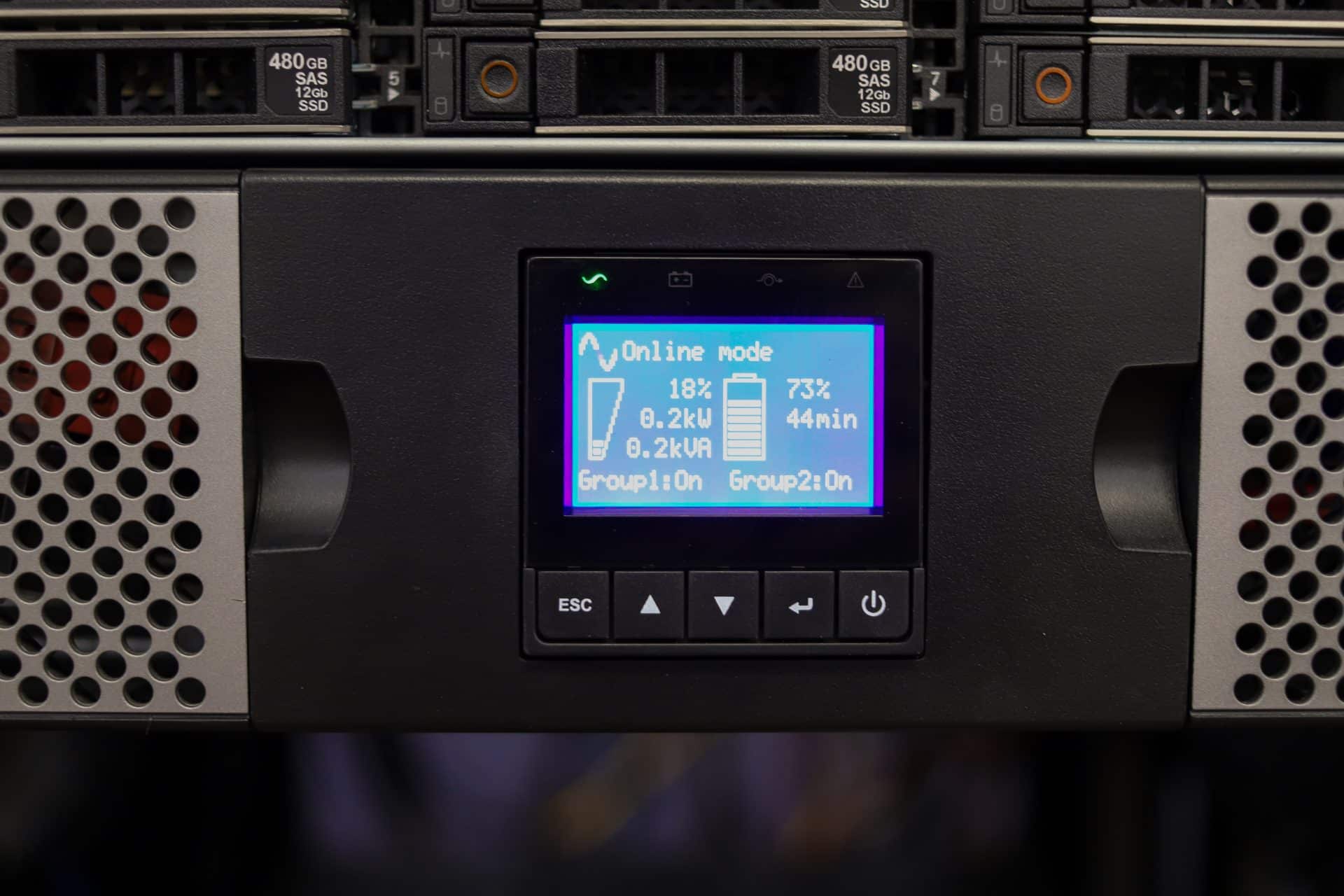
With IPM2, we actually did a fairly deep dive of IPM a few years ago. IPM2 is all about managing and monitoring power devices in both physical and virtualized environments. The software gives admins alerts if something goes wrong, but better yet, IPM2 leverages automation to fix things. If something goes wrong, IPM2 gives users lots of ways to correct them.
VPM allows the remote monitoring of the power of up to thousands of PDU and UPS device. This is done through an intuitive GUI. VPM is vendor agnostic. The software alerts for when devices need to be replaced proactively versus reactively. And VPM can deliver real-time analytics so admins know what is going on with power in their facility.
PredictPulse Insight is a cloud-based remote monitoring and predictive analytics service. Like the above, PredictPulse can predict potential failures and allow users to proactively replace the devices and avoid unscheduled downtime. Subscribing to the service means Eaton is keeping an eye on the devices and admins can worry about other things. And if you can schedule downtime, users can save on costs and downtime in the future.
Users can also leverage the NETWORK-M2 card (initially looked at more in-depth here). The main screen gives us an overview of the four most critical things to worry about with a UPS, energy flow, outlet status, active alarms, and environment.
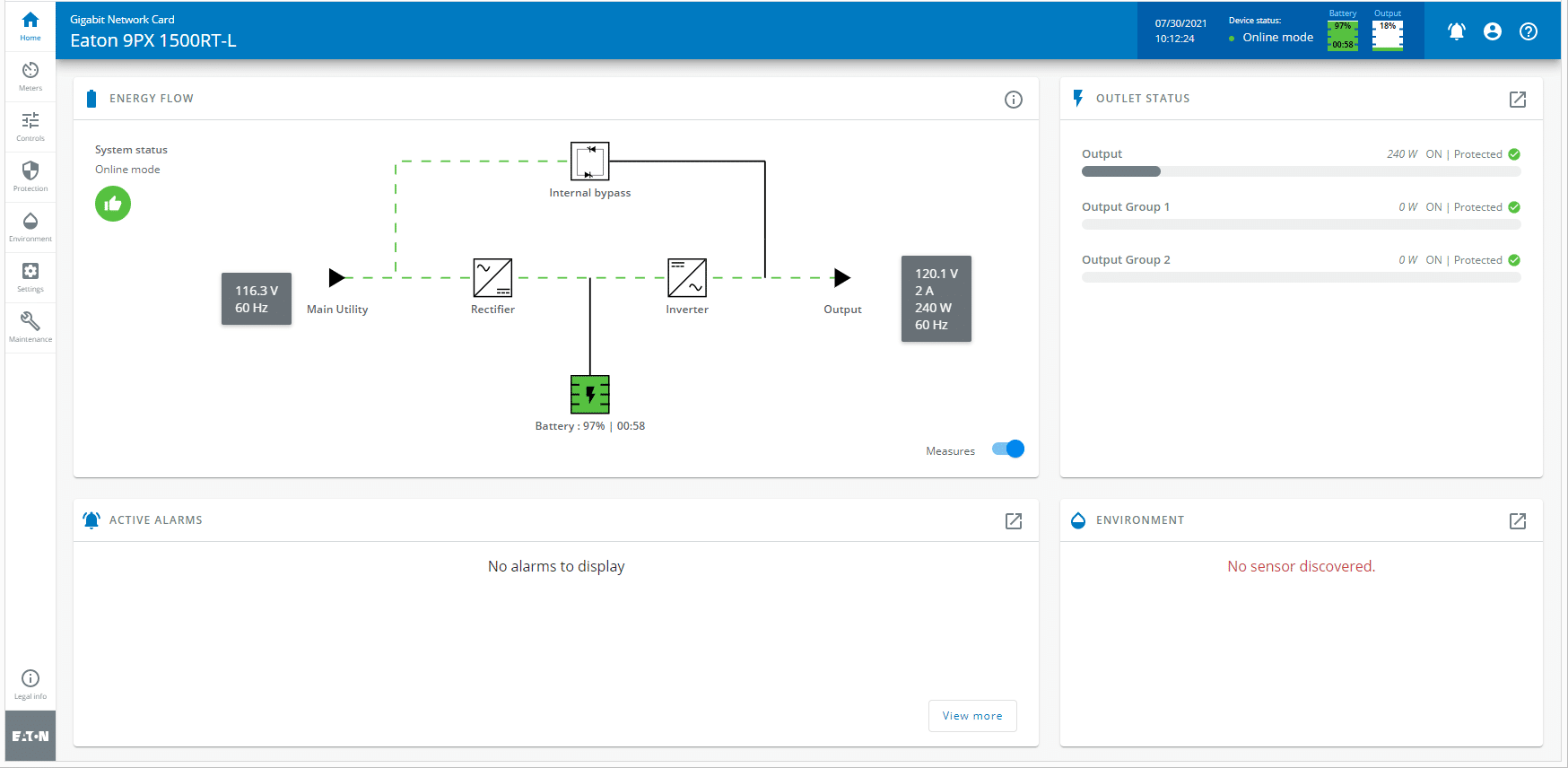
The main tabs run down the left side and include Home (above), Meters, Controls, Protection, Environment, Settings, and Maintenance. On the Meters Tab, one can see a bit deeper into the battery and energy flow. We see the voltage and frequency, the output, battery status, and battery health.
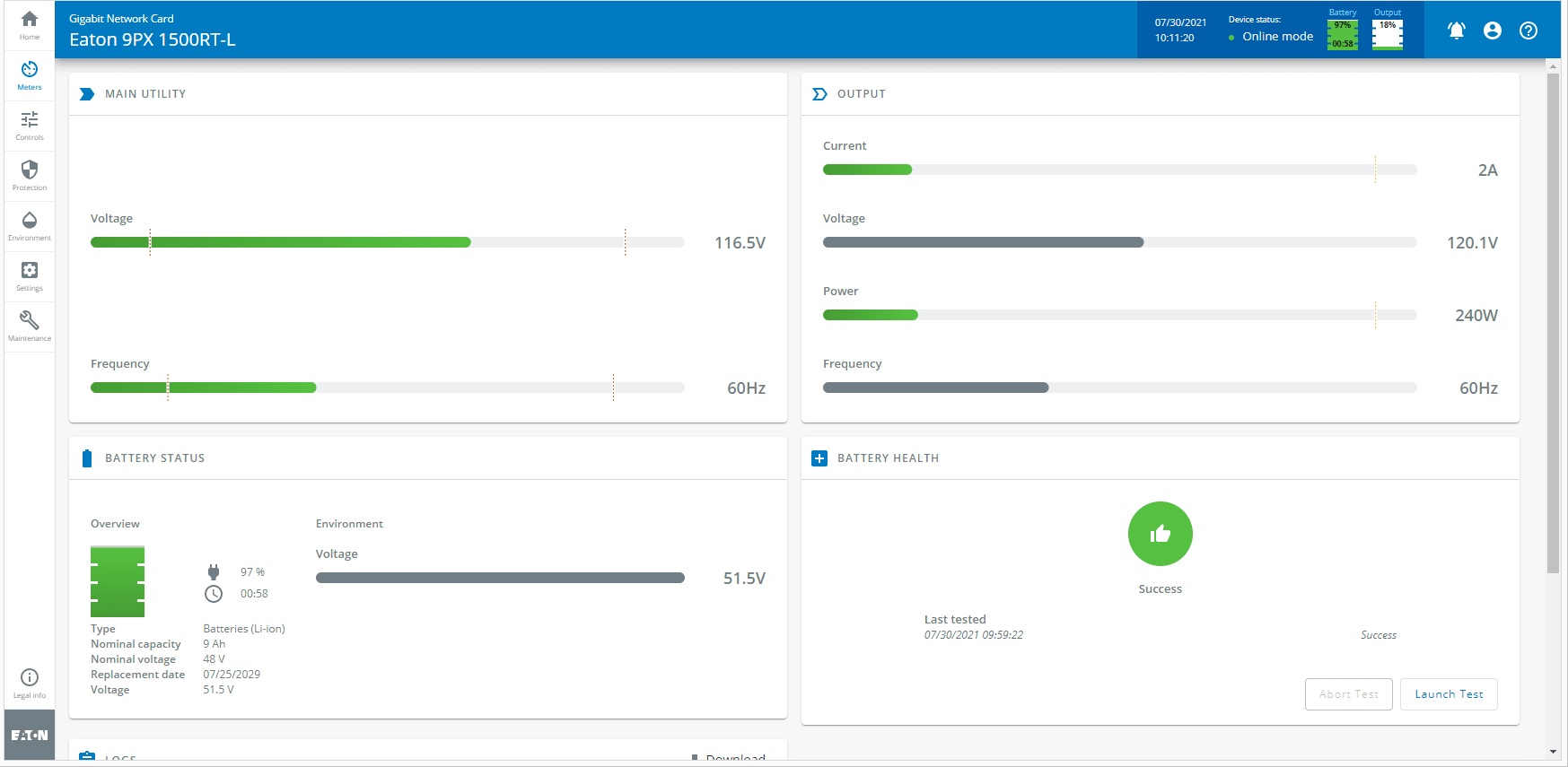
The other major tab we’ll look at is the Controls tab. As the name implies, users can control the entire UPS or certain outlet groups here. The option for safe off and safe reboot can be selected. And the status is displayed.
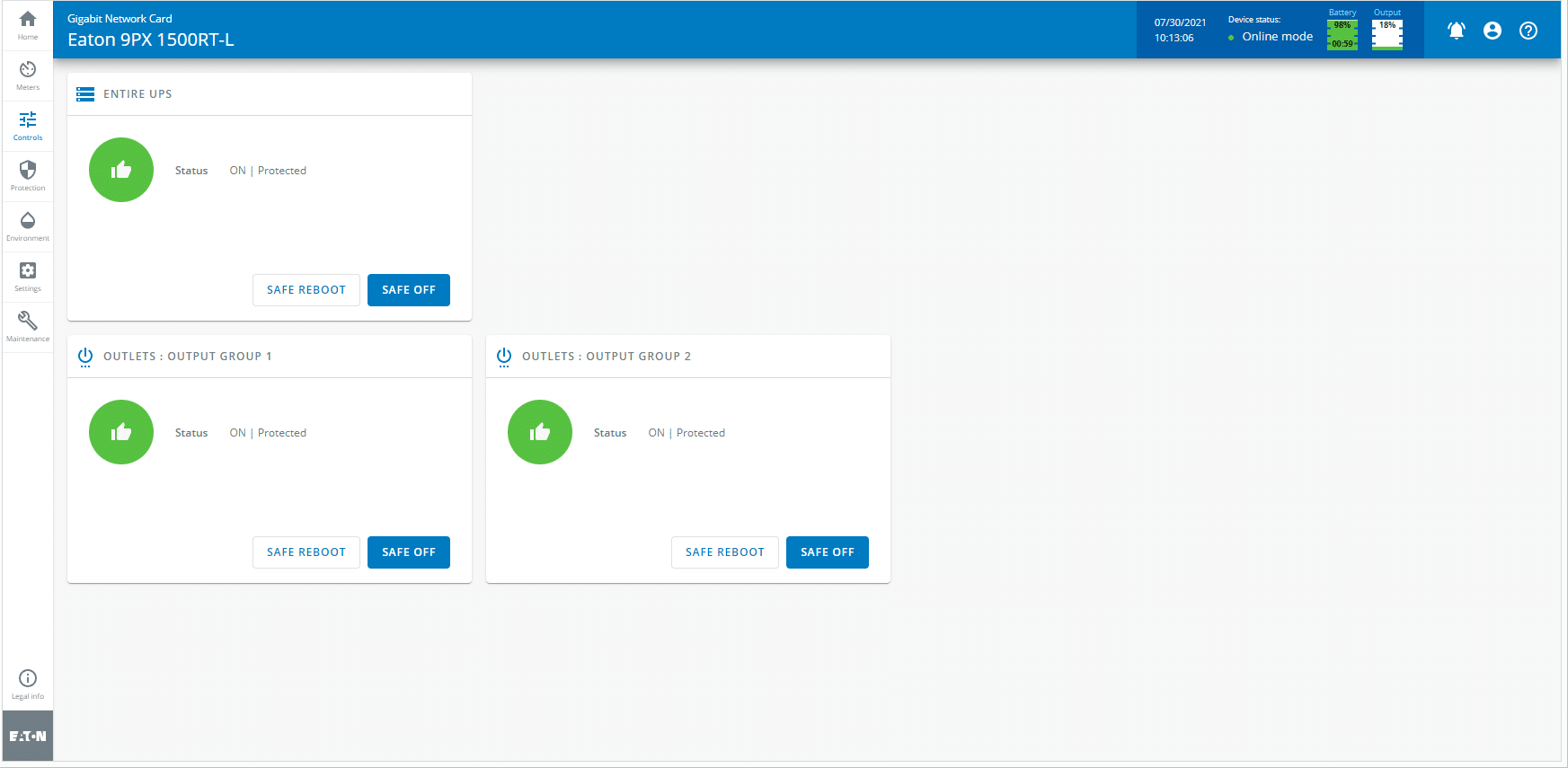
Conclusion
The Eaton 9PX Lithium-ion UPS supports power ratings from 1.5 to 3 kVA and leverages Lithium-ion battery technology instead of lead-acid. Lithium-ion technology comes with longer battery life, more even charge, a faster recharge, and a longer warranty. Lithium-ion batteries are also lighter and denser for the same footprint, which can make a difference when you only have so much room in an edge location for instance. Aside from lasting longer and being safer, the new 9PX comes with all of the software options that Eaton is known for to monitor power.
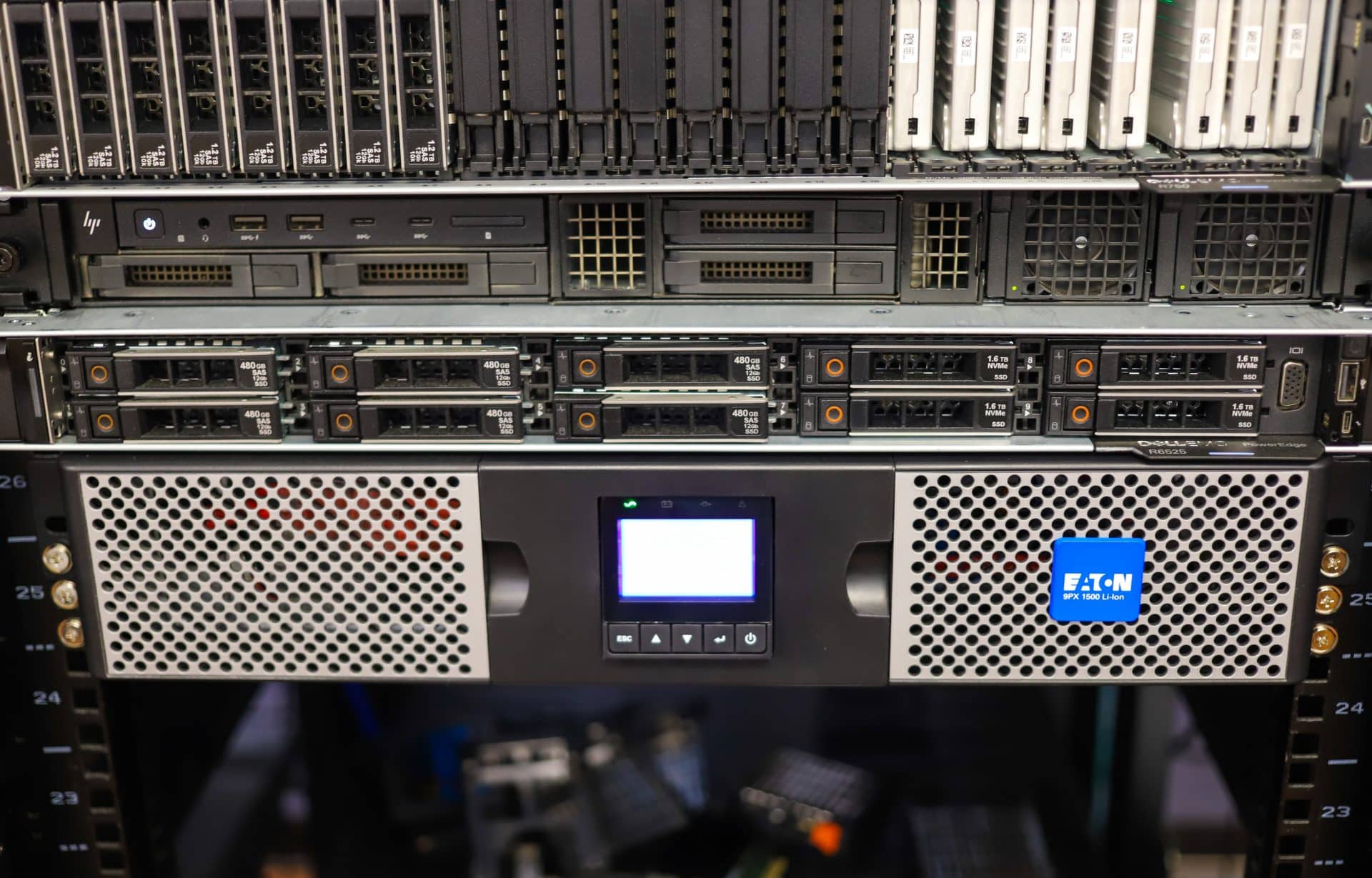
At StorageReview, we are leveraging the Eaton 9PX lithium-ion UPS in a small server room. In the field, this unit would be perfect for a small retail location or perhaps a bank, where the goal is to ensure uptime and resilience for key systems. Depending on the use case, this could be something like point-of-sale and access control systems. Sizing is key, but our little unit can hold up a few servers, storage, and switching in the event of a temporary unplanned outage.
As usual, we found the 9PX to be easy to set up and get going. Unbox it, get it a power supply, plug in what we want to be protected, and we were good to go. While there are several management options, we had the network card and that was the easiest method to get management up and going. Truth be told, the 9PX would be fine without these on a one-off basis. That said, for IT admins managing larger Eaton deployments, the variety of management software does add a lot of value when it comes to visualizing and proactively managing these environments.
Lithium-ion UPS units have so much to offer when compared to lead-acid. Now that larger capacity units are coming to market, it’s a simple leap to modernize edge deployments. Eaton is typically at the front of the pack when it comes to offering new power technology to the market and the 9PX lithium-ion is no different.
Eaton 9PX on TikTok:




 Amazon
Amazon